News
My favourite hedgerow bird.
20th June 2023
20th June 2023
Bullfinches are my favourite hedgerow birds. They are monogamous, gentle and really beautiful - what's not to like about them? I love the male's song, it appears to consist of chords rather than notes and it is so delicate and always just on the edge of your hearing. Sometimes you question what you are hearing and then you realise it's a male Bullfinch singing. They are in my garden all year round and they breed some years, deep in cover in the Hazel hedges, but they rarely show right out in the open for me to photoghraph.
Today I spent an hour down in my little nature reserve just watching if anything was coming in to drink in my elevated pond in this humid weather. Very briefly both male and female Bullfinches came in for a quick drink and then disappeared - it's what they usually do, so no surprise!
I was going to call it a day becaus it's so uncomfortably hot in my wooden hide when suddenly out of nowhere a male Bullfinch landed right on one of my perches for about ten seconds. In my garden this is really unusual behaviour, they just don't do it, but I wasn't complaining - it was lovely to see him out in the open for once.
Notice the conspicuous white rump patch which always shows very prominently on male and female when they fly - always a good way to identify Bullfinches.
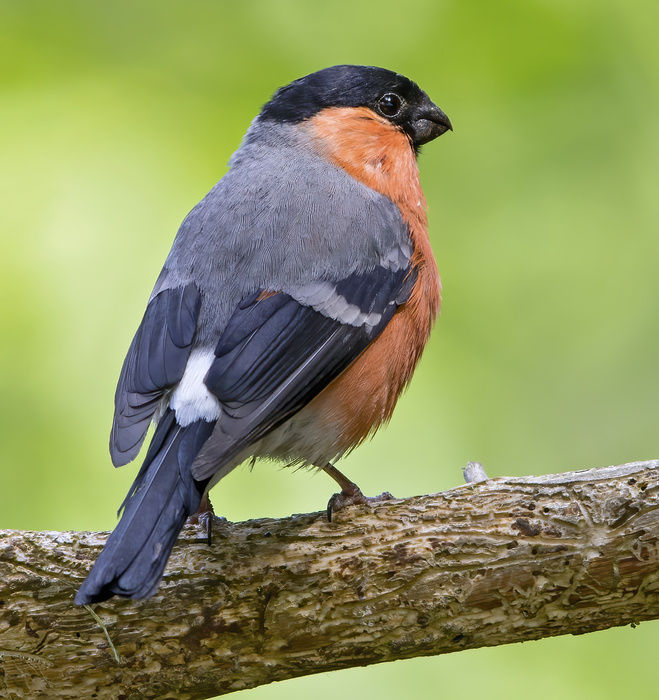
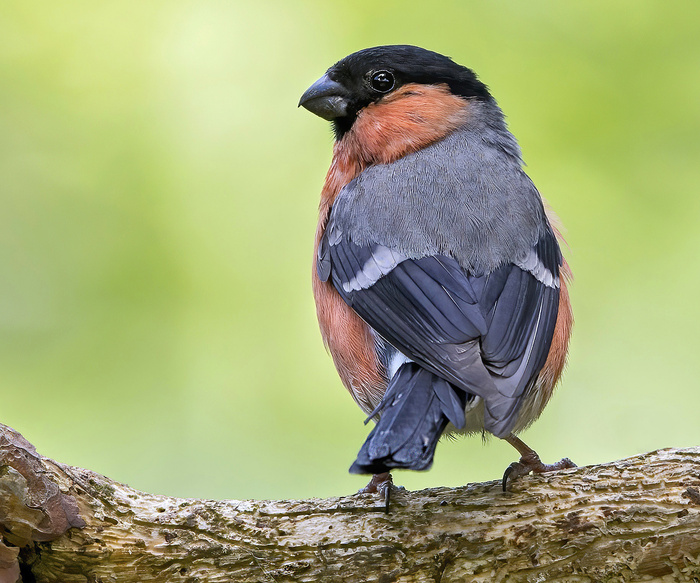
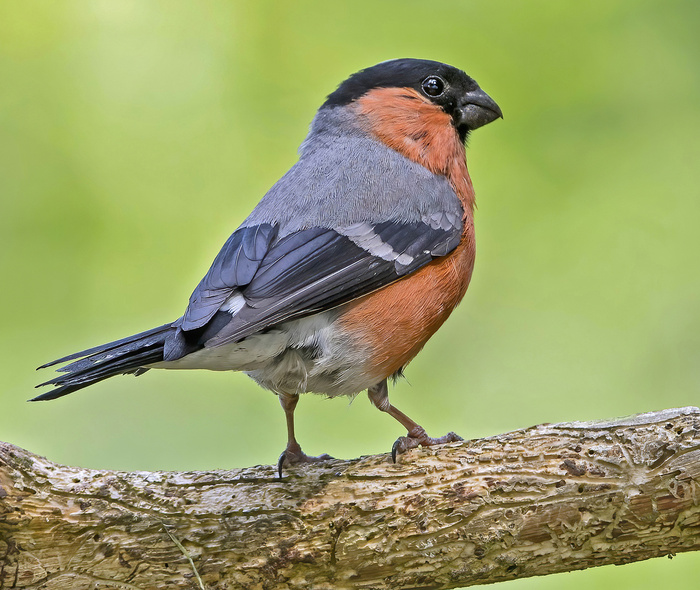
Today I spent an hour down in my little nature reserve just watching if anything was coming in to drink in my elevated pond in this humid weather. Very briefly both male and female Bullfinches came in for a quick drink and then disappeared - it's what they usually do, so no surprise!
I was going to call it a day becaus it's so uncomfortably hot in my wooden hide when suddenly out of nowhere a male Bullfinch landed right on one of my perches for about ten seconds. In my garden this is really unusual behaviour, they just don't do it, but I wasn't complaining - it was lovely to see him out in the open for once.
Notice the conspicuous white rump patch which always shows very prominently on male and female when they fly - always a good way to identify Bullfinches.



Cuckoo's favourite post is no more.
01st June 2023
01st June 2023
Between two particular conifer plantations in the Brecon Beacons there is an area of 'Clearfell'. (Nothing unusual in that I hear you say) but right in the middle of this clearfell there was one old rotten tree trunk about twenty feet high and it stood out like a sore thumb amongst the fallen branches. A number of times I witnessed Cuckoos flying from one plantation to the other and perching on this tree trunk to survey the area. I started to see an opportunity for an image in this situation, so a couple of years ago I manhandled a few of the fallen branches to form a kind of 'Teepee' which would act as a natural hide. This construction was about thirty feet from the tree trunk the Cuckoos were perching on. At first light one morning I positioned myself inside the Teepee and waited, for some time I must admit, for a Cuckoo to start calling. After much anticipation a male bird came in and landed right in front of me and this happened a number of times providing me with some quite decent images.
This old tree stump was the basis for some nice photographic images of these iconic spring birds because they were always close up and the background was always a nice pastal shade.
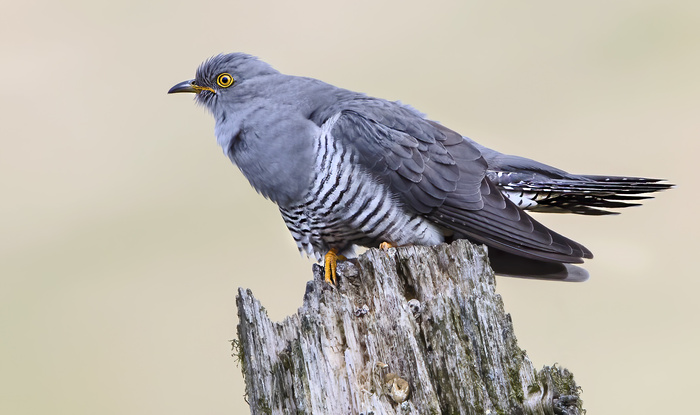
Last week I was driving past these two conifer plantations and I thought I'd stop and have a look to see if 'old faithful' was still standing. However, what greeted me was disappointment, it was lying flat on the clearfell floor amongst the other debris. I was thinking of setting up there next spring (because it's too late this year) if there were any Cuckoos around the plantations, but it would be far too heavy to re-erect.
All good things come to an end they say.....
This old tree stump was the basis for some nice photographic images of these iconic spring birds because they were always close up and the background was always a nice pastal shade.

Last week I was driving past these two conifer plantations and I thought I'd stop and have a look to see if 'old faithful' was still standing. However, what greeted me was disappointment, it was lying flat on the clearfell floor amongst the other debris. I was thinking of setting up there next spring (because it's too late this year) if there were any Cuckoos around the plantations, but it would be far too heavy to re-erect.
All good things come to an end they say.....
Woodchat Shrikes.
30th May 2023
30th May 2023
When you see a Woodchat Shrike in the UK it's a nice find, not a huge deal but still worth going to see for bird listers. However, all the shrikes usually seen in the UK, (except for some very isolated breeding of Red Backed for instance which is kept 'Quiet' for obvious reasons) are single birds. On Lesvos it is still usually single birds that are photographed, although they obviously breed in numbers there. We came across a pair as I mentioned in a previous blog when the female bird was quite confiding when she was out looking for food, allowing me to approach her quite closely. After this very nice encounter we carried on walking but on our return past their obvious nesting area, which we did not stop at to avoid disturbance, there was no sign of them. However, further on we could now see both male and female in a tree down the track. They were just contendedly perched next to each other totally ignoring our presence as we approached. I took a few shots from a distance which I thought the birds were comfortable with and we skirted around past them as they remained there just watching us walking past. A quite unusual situation to find two very nice quality birds posing nicely for a photograph - I wasn't complaining!
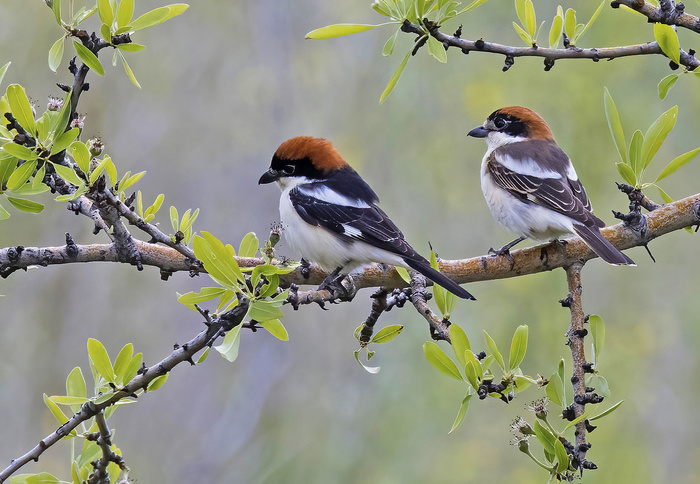

Cuckoo in flight.
28th May 2023
28th May 2023
I haven't had time to look for Cuckoos this spring and I don't think I'll be able to either. However, a chance encounter happened this week when we went out for a drive in between working at home. A cuckoo called and flew past us when we were parked up having a cup of coffee. I had my go to lens with me in the boot, I don't have to say what it is now after all the previous blog posts, and I quickly took a few images as the Cuckoo was there and gone in seconds.
I never thought I'd be leaving my 600 prime lens at home on a regular basis but that is the norm now, but I fully understand why I'm doing it when I can casually capture reasonably good images without it.
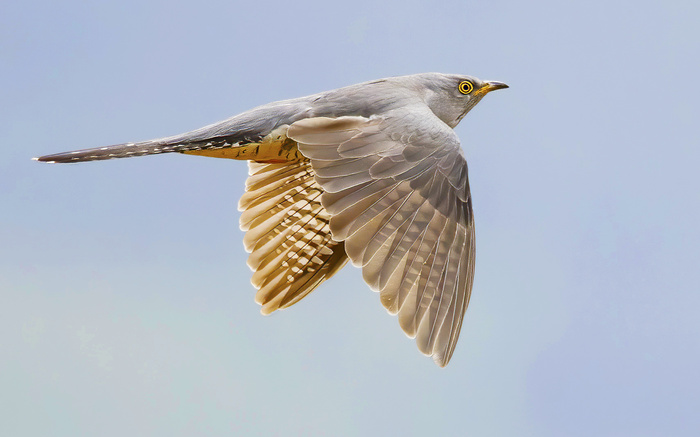
I never thought I'd be leaving my 600 prime lens at home on a regular basis but that is the norm now, but I fully understand why I'm doing it when I can casually capture reasonably good images without it.

Purple Heron.
21st May 2023
21st May 2023
A bird we didn't expect to see perched in a tree was a Purple Heron, they are usually, for us anyway, skulking aroud a reed bed being quite elusive. One morning, however, we were out early to see what was on the local river before returning to to the hotel for breakfast. We rounded a corner and there was a Purple Heron sunbathing in the early morning sun, obviously warming up after a cold night in the reed beds.
A total but very welcome surprise!
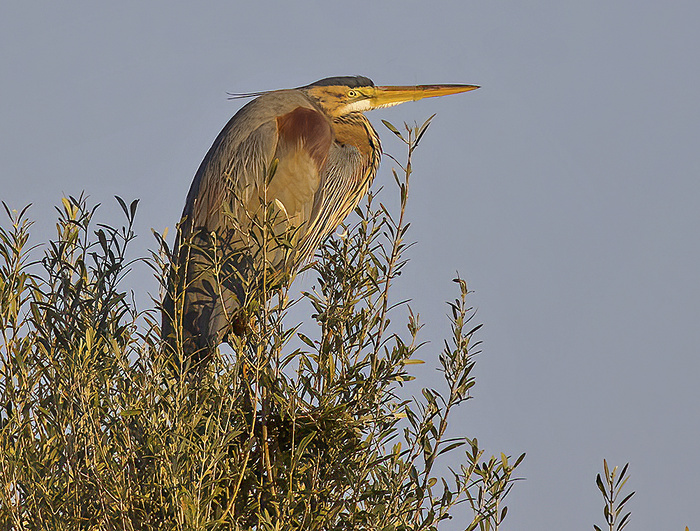
A total but very welcome surprise!

Hoopoe in a tree , a slice of luck.
21st May 2023
21st May 2023
Hoopoes are very frustrating birds for the photographer in many respects, they are usually seen on the ground digging around in not the best positions or alternatively flying away from you. They rarely pose nicely – but sometimes there’s an exception to the rule. As we were driving along a dusty track a large bird flew up off the ground in front of us and we could see it was a Hoopoe. We expected it to fly off into the distance as usual but it didn’t, it perched in a tree about ten yards away and even better it was nicely framed by the surrounding foliage. I stopped the car and carefully placed my lens on a beanbag I always keep ready. I took a couple of shots before it inevitably wheeled away, but on the back of the camera I could see I had just caught it in the frame.
A total slice of luck out of the blue!
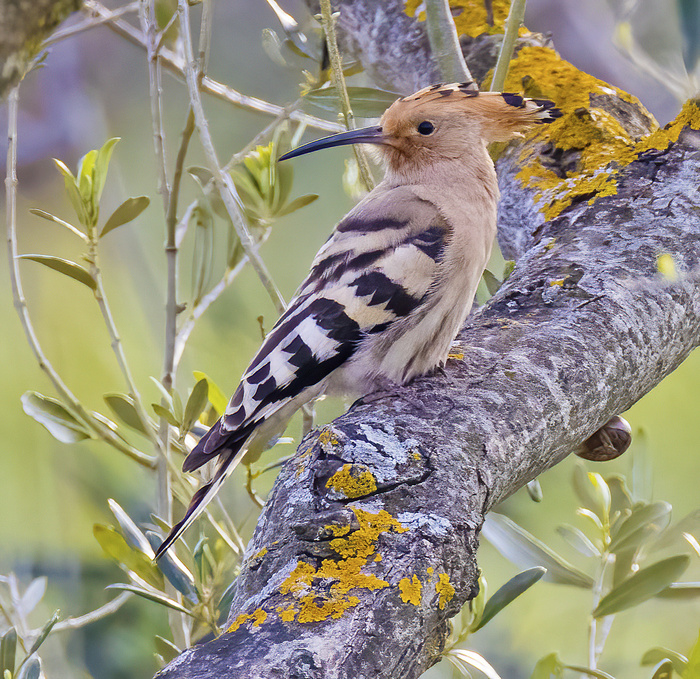
A total slice of luck out of the blue!

Barred Warbler.
21st May 2023
21st May 2023
A bird that is seen very infrequently anywhere really is the Barred Warbler, especially the adult males. On Lesvos this is no exception and it was very nice to catch one flitting around some trees early one morning. They are so elusive, keeping to deep cover and only giving brief and tantalising views. This bird showed very fleetingly and it’s not the best shot, but it was still nice to get a record.
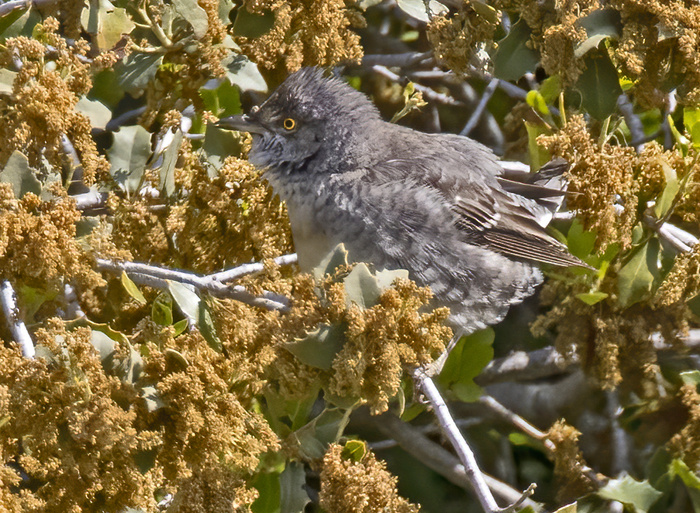

Black Headed Bunting.
19th May 2023
19th May 2023
Black Headed Buntings arrive on Lesvos at the end of April in numbers. These birds although quite common are in the right light quite stunning. They perch in prominent positions and sing all day and if you can get the right side of them with the sun behind you they are glorious.
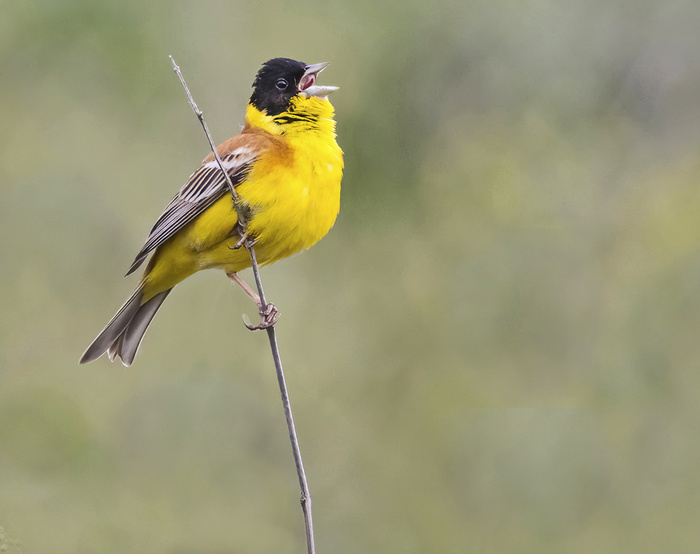

Wood Warbler - the sound of spring.
19th May 2023
19th May 2023
I always like to try and get a shot of a Wood Warbler in the spring. They are one of my favourite little warblers. They live up to their name by breeding in the light mixed woodlands of the Brecon Beacons. They like an airy canopy and a bit of space between the trees to fly around and display. I love their spinning coin song and their multiple sharp little 'Peeps' when they call. This morning I was in such a woodland early and I was watching a bird calling and singing and displaying frequently. I positioned myself behing some foliage and watched and waited for an opportunity to try and get a shot. I was again using my Canon R5 with my Canon RF 100-500 f7.1 lens and a Canon speedlight 430EX mounted on the hot shoe for a bit of fill in flash. I couldn't have walked in these type of woods with my EF600 f4 and tripod, it's just too big and awkward. This little Canon RF 100-500 is so versatile for this type of shooting.
A lovely morning with this glorious little bird.
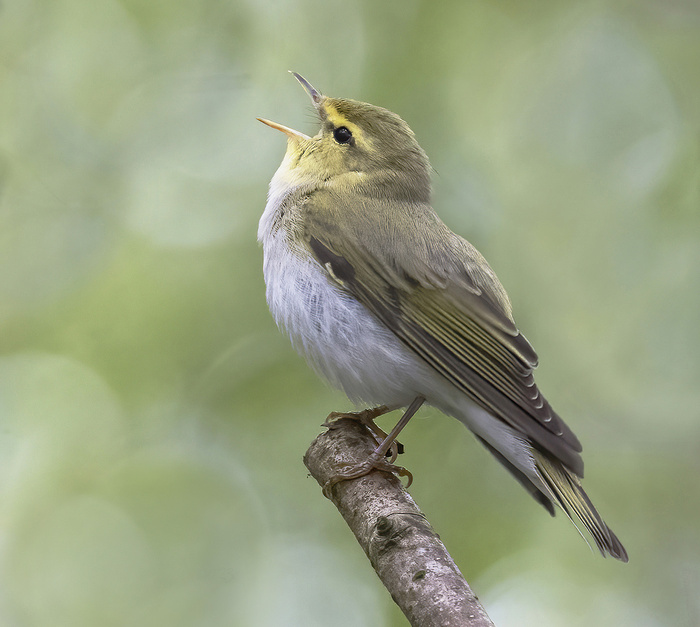
A lovely morning with this glorious little bird.

Yellowhammer.
15th May 2023
15th May 2023
For some reason a male Yellowhammer has been coming to my garden for three years and singing all day long. I'm not complaining because they are such a lovely bird that used to be common on farmland but unfortunately no longer.
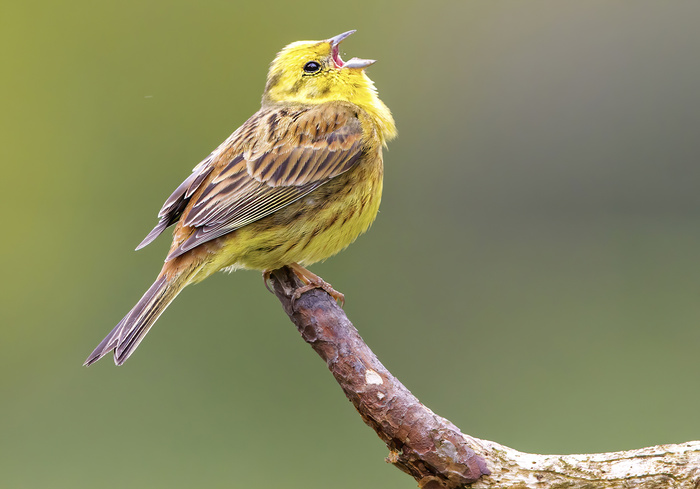
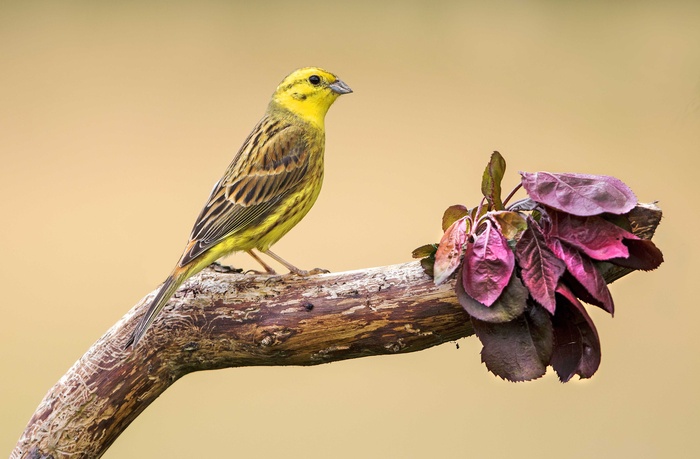


The secretive Long Eared Owl.
08th May 2023
08th May 2023
Long Eared Owls are very difficult to see well in the UK, they are quite strictly nocturnal and spend their days roosting in dense copses out of sight.
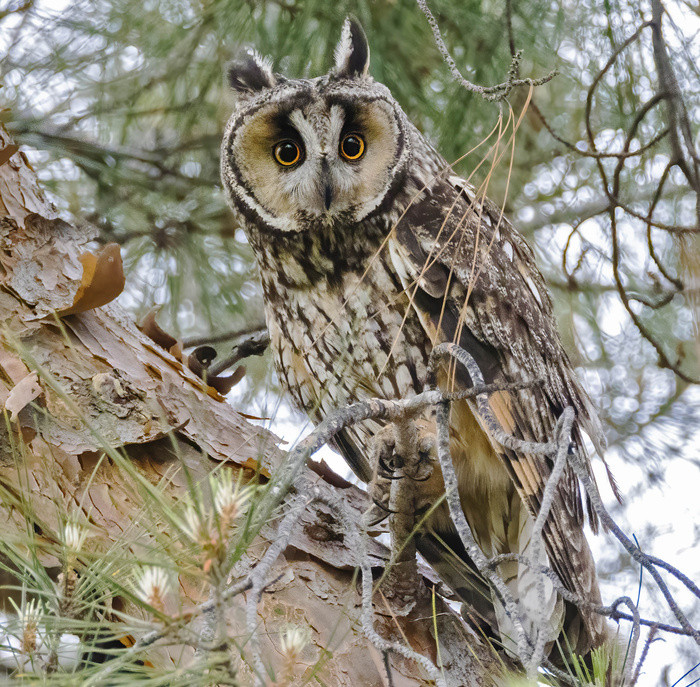
Their only give away is the adult’s deep and far carrying hoot – like a mini foghorn. The young in the spring utter a call akin to a squeaky gate hinge, other than this they are ostensibly unobtrusive.
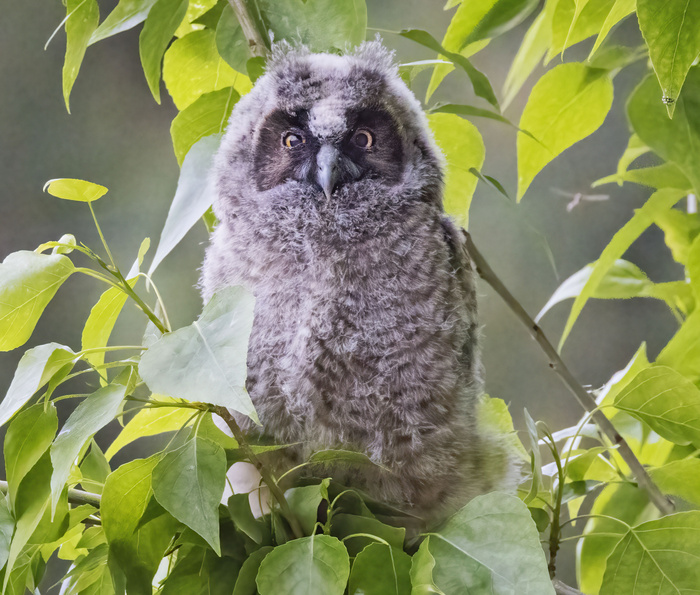
In Lesvos they roost and breed, often in Corsican pines and frequently in the middle of towns. This is the best place to see them and it’s just a matter of closely scanning the branches for roosting birds.
We came across two adults and two chicks in one such location near to our hotel and we were very lucky to see the adults out hunting in the dark because they were passing street lights regularly on their way back and fore to feeding the youngsters.
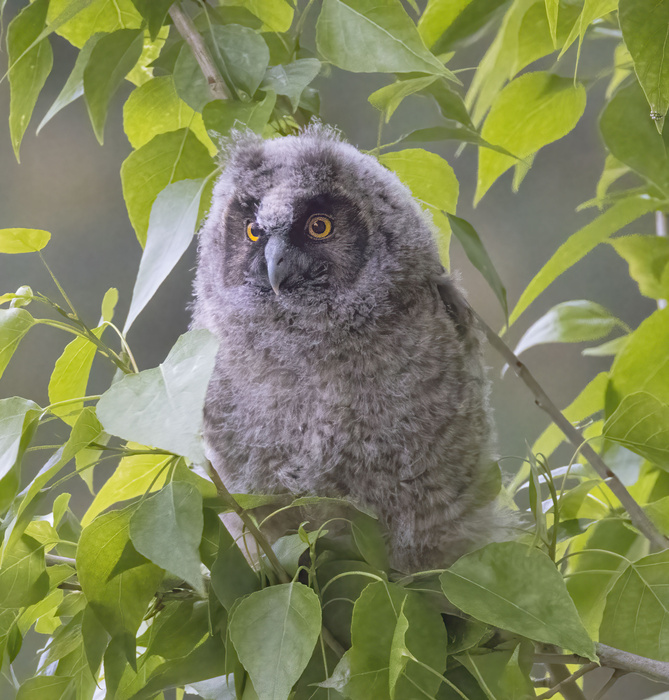
However, one afternoon one of the chicks got a little too confident and fell out of the roosting tree which was a big problem because there are quite a few feral cats around Lesvos towns and they were obviously a great danger to this young bird.
Fortunately there was a Dutch bird ringer around and he caught the young owl.
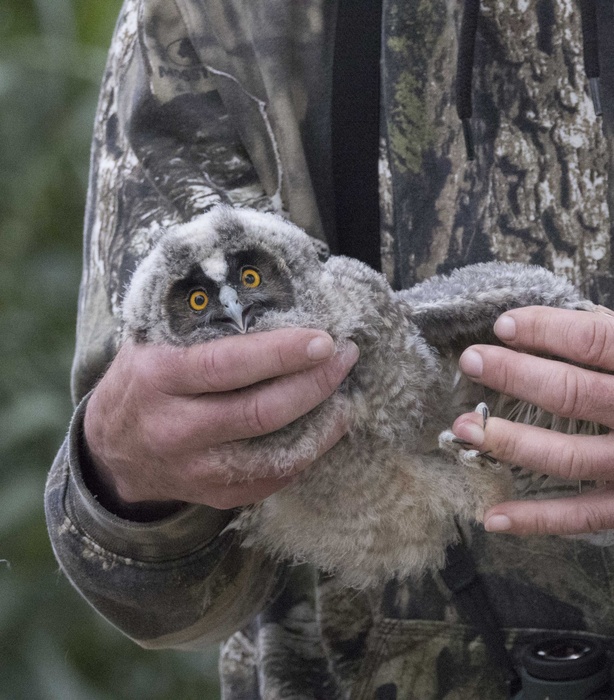
And another birder got hold of a long ladder and reinstated the bird back up from where it had fallen.
All’s well that ended well – in that situation anyway.

Their only give away is the adult’s deep and far carrying hoot – like a mini foghorn. The young in the spring utter a call akin to a squeaky gate hinge, other than this they are ostensibly unobtrusive.

In Lesvos they roost and breed, often in Corsican pines and frequently in the middle of towns. This is the best place to see them and it’s just a matter of closely scanning the branches for roosting birds.
We came across two adults and two chicks in one such location near to our hotel and we were very lucky to see the adults out hunting in the dark because they were passing street lights regularly on their way back and fore to feeding the youngsters.

However, one afternoon one of the chicks got a little too confident and fell out of the roosting tree which was a big problem because there are quite a few feral cats around Lesvos towns and they were obviously a great danger to this young bird.
Fortunately there was a Dutch bird ringer around and he caught the young owl.

And another birder got hold of a long ladder and reinstated the bird back up from where it had fallen.
All’s well that ended well – in that situation anyway.
Lesvos
06th May 2023
06th May 2023
Susan and I have just returned from a couple of weeks on the Greek island of Lesvos - yesterday. It's a bit of a shock from having warm sunny days with Bee eaters trilling above you and Black Storks drifting past your hotel balcony to this grey and miserable weather we have here - I hope it improves soon. Blog posts will follow and a full trip report will appear in due course.
Confiding Woodchat Shrike.
01st May 2023
01st May 2023
There are many opportunities to photograph birds on the island of Lesvos, that’s why we and many others travel there. I can’t think of a better place in Europe in late April and early May to have such a variety of quality birds to see. Sometimes these birds are tolerant and you can take (up to a point) advantage of this. On one such morning we had been watching a pair of Woodchat Shrikes perching on top of a thicket which they were obviously nesting in. After a while the female bird flew off to hunt for food and I could see her perched on an old tree stump about fifty yards away. I slowly approached this tree stump and after every five yards I stopped and took a few shots. I always work this way because if the bird flies away at least you have something. However, this bird was totally unfazed by my approach and it just looked at me and preened a little and looked around totally ignoring me. Remarkably I got to within ten yards of her and took my final shots before she casually dropped to the ground and caught an insect and flew further on. It’s always nice when you have an experience like this with a very nice bird.
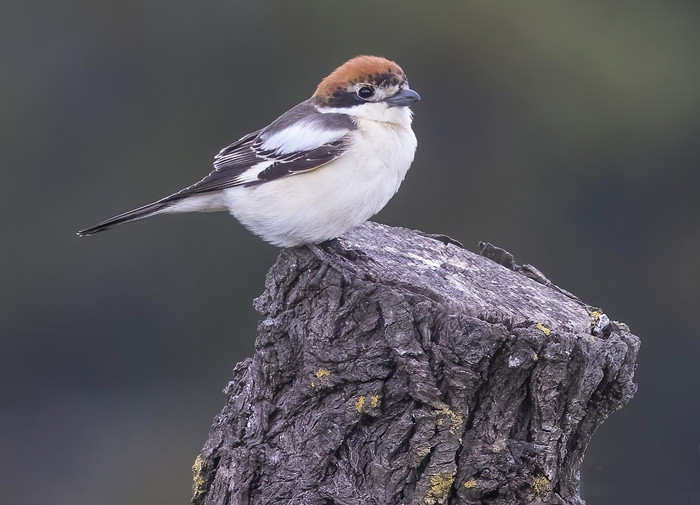

Two iconic Lesvos birds.
01st May 2023
01st May 2023
There are two iconic species that you must see and hopefully photograph on the island of Lesvos. They are Cinereous Bunting and Kruper’s Nuthatch. Their habitats couldn’t be further apart, one lives in the barren rocky mountains in the west of the island, the other in the Corsican pine forests to the east. Patience is needed to photograph both. I have a particular site for the Cinereous Bunting and it never lets me down. Almost all my images of them are perched on rocks but not this time, I managed one perched in a small bush so I’ll use that one.
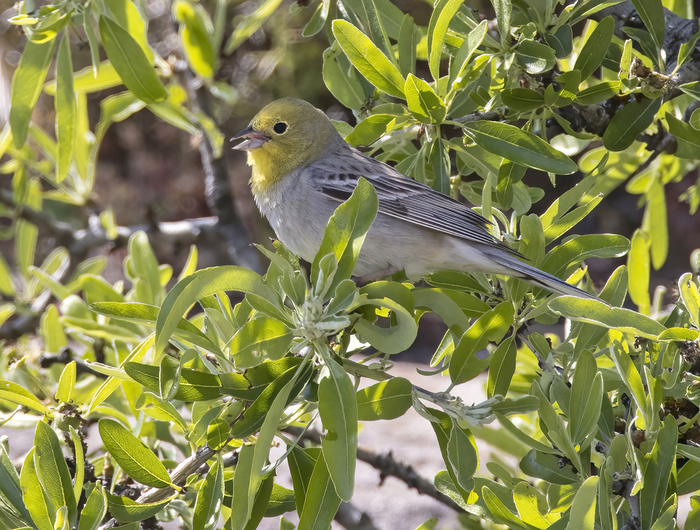
You can go to the established site for Kruper’s Nuthatch which is a place called Achladeri, which is where all the generic tour companies go. However, this site is far from guaranteed and it can get crowded because of these companies. If you, as an alternative go walking in these forests, which are extensive, you can find your own birds, and that’s what we did with results that we were very pleased with. There was nobody else there and it was so beautifully quiet, just us and the birds.
These images I took of the Kruper's Nuthatch were requested by the environmental centre lecturers on Lesvos who give talks about the island, so that was nice.
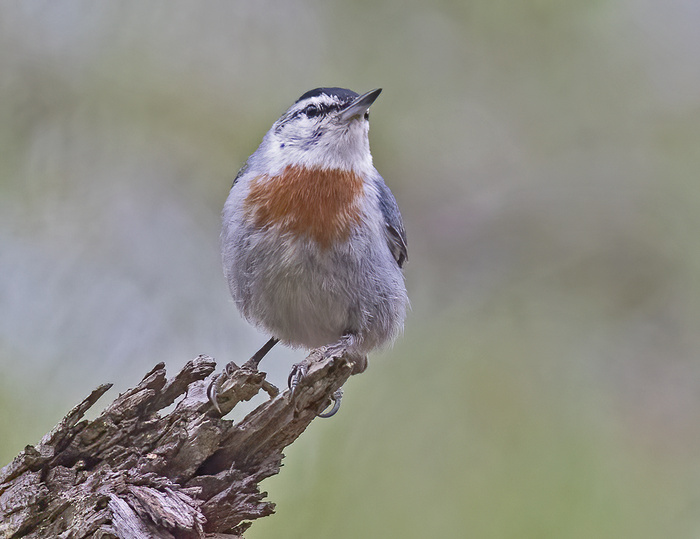
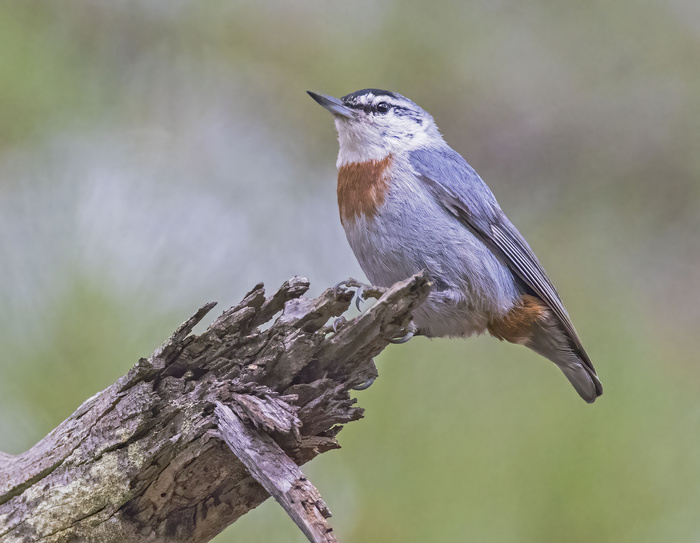
You can see why Lesvos is so prolific for birds - look at its proximity (5 miles) from the Turkish mainland.
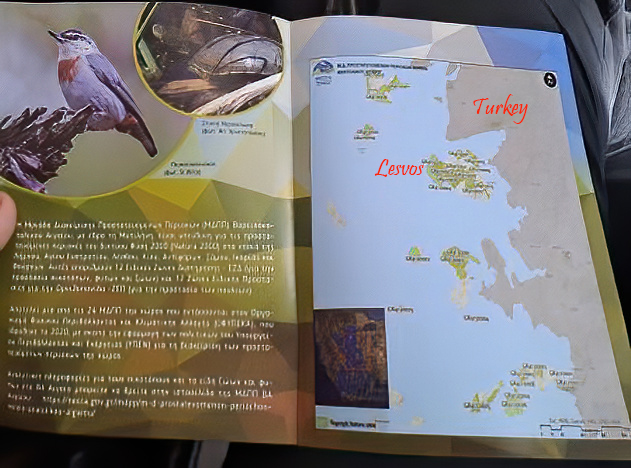
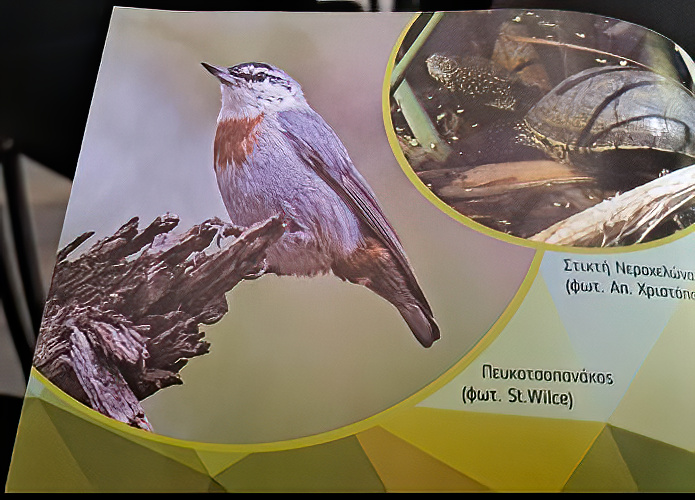

You can go to the established site for Kruper’s Nuthatch which is a place called Achladeri, which is where all the generic tour companies go. However, this site is far from guaranteed and it can get crowded because of these companies. If you, as an alternative go walking in these forests, which are extensive, you can find your own birds, and that’s what we did with results that we were very pleased with. There was nobody else there and it was so beautifully quiet, just us and the birds.
These images I took of the Kruper's Nuthatch were requested by the environmental centre lecturers on Lesvos who give talks about the island, so that was nice.


You can see why Lesvos is so prolific for birds - look at its proximity (5 miles) from the Turkish mainland.


The beautiful Red Footed Falcon.
01st May 2023
01st May 2023
One advantage of going to Lesvos early is that you could see the Red Footed Falcon passage. These beautiful birds come through in late April and are usually gone by the first few days of May. They hunt insects on the wing and also come down to the ground to feed.
They are a stunningly beautiful bird anywhere.
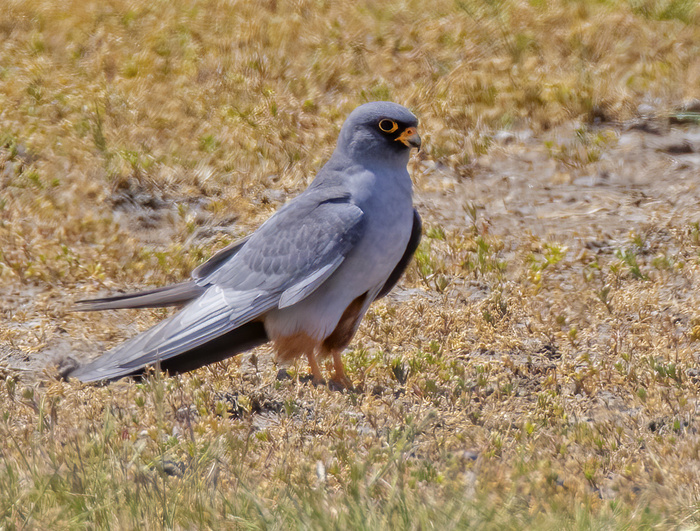
But it is on the wing where they are at their most spectacular. If you can line one up against a nice background on a bright day they are totally gorgeous.
We were driving along one of the quiet roads one sunny afternoon when we could see birds hunting over some fields and this could have been Swallows, Swifts or Bee-eaters so we stopped to take a look and to our pleasant surprise we could see they were indeed Red Footed Falcons.
We quickly parked up to watch them because they disappear as quickly as they come – once the insects are eaten that’s it. I began to try and take some shots but it’s not easy with these fast moving and very aerial falcons. However, with the Canon R5’s tracking ability and the lightweight and very manoeuvrable Canon RF100/500 it is possible.
I had the camera set to crop mode and the Canon RF 1.4 tele converter attached. This gave an image stabilized focal length of 1120mm @ f10.
You don’t get many images that are just right because usually there is something that’s in the way, or the bird is moving or looking away at the wrong time. Even the light bouncing off your subject at the wrong angle can ruin a shot.
At the risk of becoming very boring I again extoll the virtues of the Canon RF100-500 lens, even with a tele converter attached there is no slowing up of the focussing or degradation in image quality.
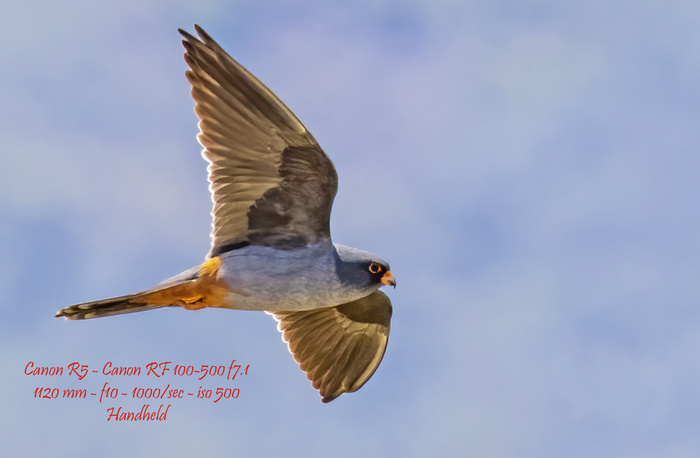
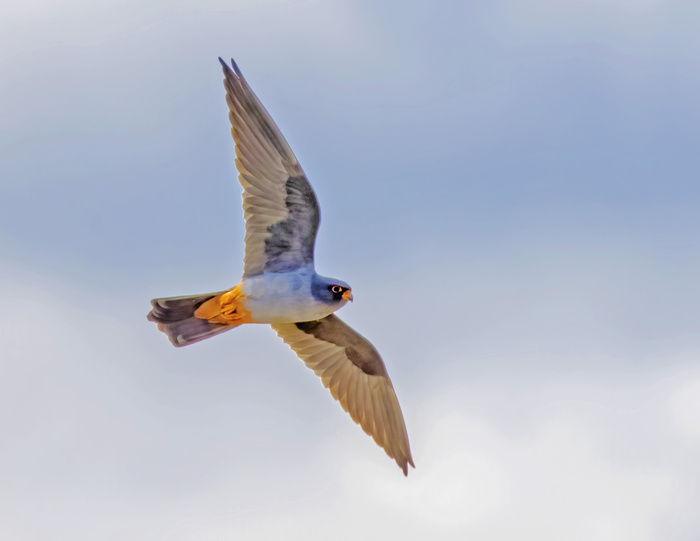
It is the perfect travel lens because generally speaking going on holiday means you are in a sunnier country and small apertures don’t matter because of the abundance of light. I can imagine that this lens would be perfect for big game in Africa with its ability to zoom in and out. It’s also so light and compact, it can fit in a very small bag in hand luggage.
They are a stunningly beautiful bird anywhere.

But it is on the wing where they are at their most spectacular. If you can line one up against a nice background on a bright day they are totally gorgeous.
We were driving along one of the quiet roads one sunny afternoon when we could see birds hunting over some fields and this could have been Swallows, Swifts or Bee-eaters so we stopped to take a look and to our pleasant surprise we could see they were indeed Red Footed Falcons.
We quickly parked up to watch them because they disappear as quickly as they come – once the insects are eaten that’s it. I began to try and take some shots but it’s not easy with these fast moving and very aerial falcons. However, with the Canon R5’s tracking ability and the lightweight and very manoeuvrable Canon RF100/500 it is possible.
I had the camera set to crop mode and the Canon RF 1.4 tele converter attached. This gave an image stabilized focal length of 1120mm @ f10.
You don’t get many images that are just right because usually there is something that’s in the way, or the bird is moving or looking away at the wrong time. Even the light bouncing off your subject at the wrong angle can ruin a shot.
At the risk of becoming very boring I again extoll the virtues of the Canon RF100-500 lens, even with a tele converter attached there is no slowing up of the focussing or degradation in image quality.


It is the perfect travel lens because generally speaking going on holiday means you are in a sunnier country and small apertures don’t matter because of the abundance of light. I can imagine that this lens would be perfect for big game in Africa with its ability to zoom in and out. It’s also so light and compact, it can fit in a very small bag in hand luggage.
The snake hunter of Lesvos.
01st May 2023
01st May 2023
After our second visit to the Meladia valley in Lesvos where we met the Greek twitcher (previous blog) we were travelling back on the return journey out of the valley not expecting anything much. We had seen a pair of Little Bitterns at the river mouth but they were too distant for a photo and a few Shrikes were perched out on distant bushes. However, in the distance we could see a large bird sat on top of a wooden pole and after looking closer we could see it was a Short Toed Eagle now named Short Toed Snake Eagle because of its principal diet of snakes which abound in this hot and rocky habitat.
These majestic birds are seen across the whole island but usually soaring and hovering up high above the landscape looking down for prey, but they are rarely perched down as low as this bird was.
We were not optimistic about getting a shot because like all Eagles they are very wary and will fly off at the slightest disturbance. However, it was worth a try so we slowly inched the car closer until we were incredibly about twenty yards away, this was unbelievable because these bird are usually long gone by now. I shut the engine off and carefully reached for my camera out of the bag on the back seat, making no sudden movements whatsoever. This little Canon RF100-500 lens is so convenient for this type of situation, it’s so small and lightweight. I took some shots of this magnificent bird as it was just perched there scanning the area.
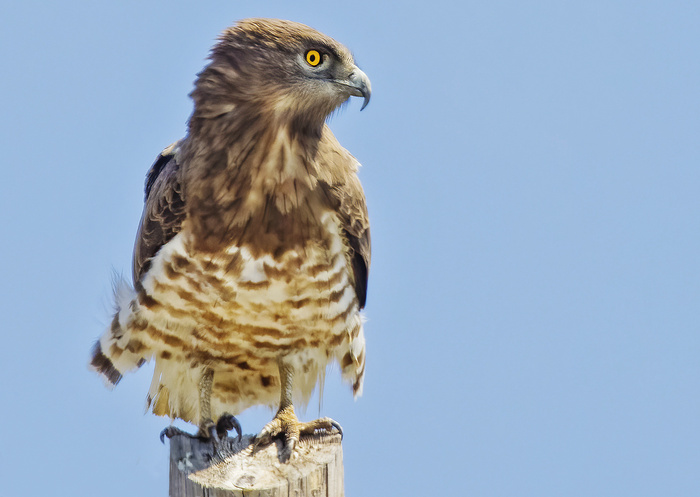
I knew realistically that this was as close as I was going to get and very soon it was going to take off and fly away. I zoomed the lens back out to get a wider shot to try and capture the take off because at 500mm there was no chance of fitting a big bird like that in the frame.
It began to shuffle about and I knew this was the precursor to take off. I focussed the lens on the eagle and then it launched into the air.
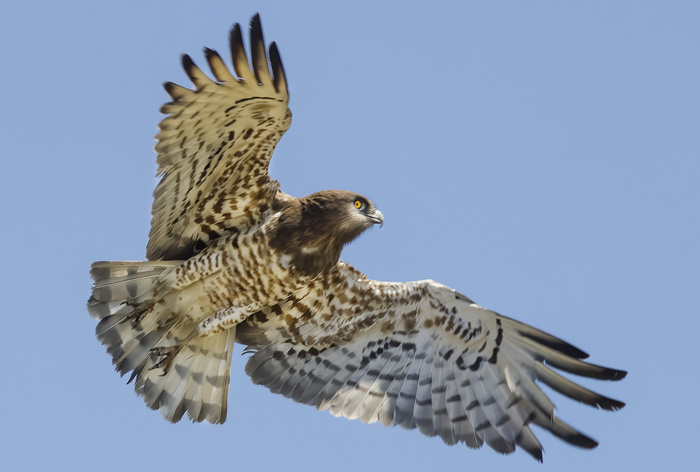
I blazed away hoping for at least one shot that was in the frame without clipping the birds wings.
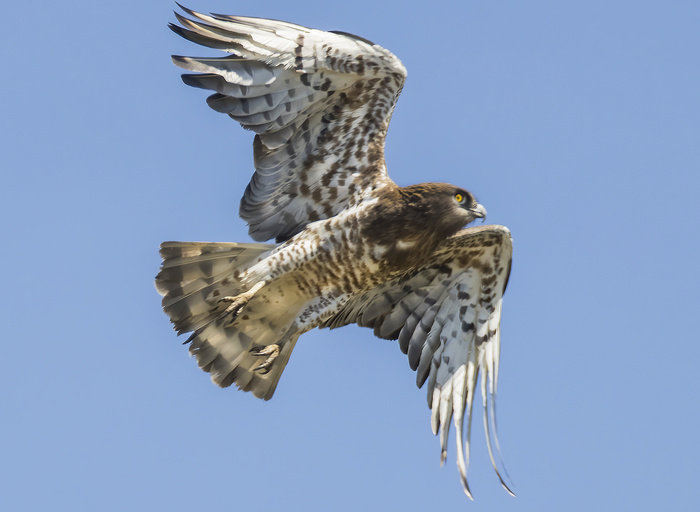
I was almost afraid to look at the camera screen to check the images. I could see some frames had clipped the bird’s wings, inevitable really, but there were some in the frame and this was a big result.
Up and away it flew into the azzure blue Aegean sky, distant in no time, really impressive.
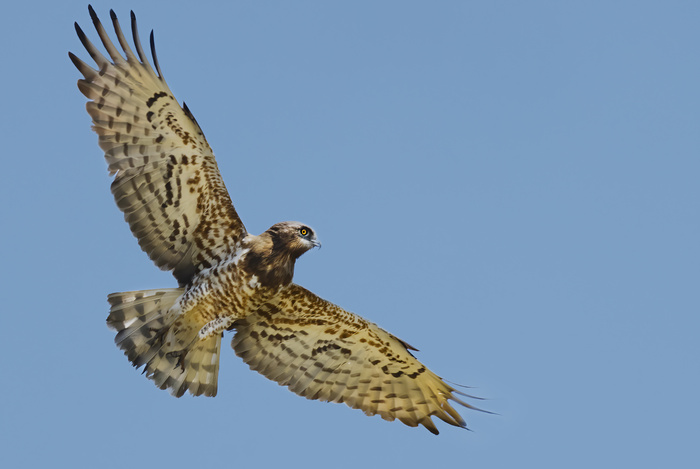
A lovely end to a day in this rough, remote but irresistible place.
These majestic birds are seen across the whole island but usually soaring and hovering up high above the landscape looking down for prey, but they are rarely perched down as low as this bird was.
We were not optimistic about getting a shot because like all Eagles they are very wary and will fly off at the slightest disturbance. However, it was worth a try so we slowly inched the car closer until we were incredibly about twenty yards away, this was unbelievable because these bird are usually long gone by now. I shut the engine off and carefully reached for my camera out of the bag on the back seat, making no sudden movements whatsoever. This little Canon RF100-500 lens is so convenient for this type of situation, it’s so small and lightweight. I took some shots of this magnificent bird as it was just perched there scanning the area.

I knew realistically that this was as close as I was going to get and very soon it was going to take off and fly away. I zoomed the lens back out to get a wider shot to try and capture the take off because at 500mm there was no chance of fitting a big bird like that in the frame.
It began to shuffle about and I knew this was the precursor to take off. I focussed the lens on the eagle and then it launched into the air.

I blazed away hoping for at least one shot that was in the frame without clipping the birds wings.

I was almost afraid to look at the camera screen to check the images. I could see some frames had clipped the bird’s wings, inevitable really, but there were some in the frame and this was a big result.
Up and away it flew into the azzure blue Aegean sky, distant in no time, really impressive.

A lovely end to a day in this rough, remote but irresistible place.
A Lesvos mega.
01st May 2023
01st May 2023
The ‘Holy Grail’ of Lesvos birding is unequivocally the almost mythical White Throated Robin. Everybody wants to see one but only a very lucky few ever get the privilege. There are only a handful of verified sightings since Greek birding records began and these sightings are all from the island of Lesvos. This is due to Lesvos’s close proximity to Turkey (about five miles) where there is sporadic breeding. To see these elusive birds with any certainty you have to visit Armenia in particular where there is established breeding.
There are certain dates etched into my memory and now April 24th 2023 is one of them. It was a warm and sunny Lesvos morning and Susan and I had been up and on the road before first light. We were travelling to the legendary Meladia valley, this valley is bisected by a very old and rough track which was in times gone by the only means of connecting the towns of Eresos and Sigri on the west of the island. Many epic bird sightings have been encountered in this valley and indeed last year Susan and I saw over a hundred Red Backed Shrikes and over five hundred Spotted Flycatchers on a morning there. Some people won’t travel the track for fear of getting stuck in the middle of nowhere and this is justifiable because over the years the track has been frequently closed because of rock falls and subsidence.
We navigated the roughest part of the track and had seen some nice birds, Little Owl, Rock Nuthatch, Red backed Shrike, etc. while Bee- eaters flew overhead – their fluty trills echoing around the valley. We stopped at the Meladia river ford – another iconic place for birders, where we encountered Common Sandpipers, Ruddy Shelduck, Lesser Whitethroat and Collared Flycatcher.
We locked the car and walked along an old rough track that runs between olive and fig groves - our targets were warblers. In particular, Orphean, Icterine, Olivaceous and hopefully Barred. After about two hundred yards an old farmer came along driving about a hundred sheep and he asked us to wait until he got the animals into a grazing meadow. We exchanged pleasantries and we were surprised by how much he knew about Wales. He thanked us for waiting and we said our goodbyes. On we walked while admiring the myriad of wild flowers that lined the track, we had seen a few birds, nothing special but that didn’t matter because it was a glorious morning and it was just nice to be out early. The habitat had now changed to low growing and quite aromatic bushes and shrubs interspersed with small rocks. Suddenly I saw something move at the bottom of a bush about ten yards away and I caught a flash of white and then some orange, my first thoughts were male Common Redstart which would have been nice, however, nothing could have prepared me for what was about to happen – a full summer plumaged adult male White Throated Robin perched on a small rock in front of me.
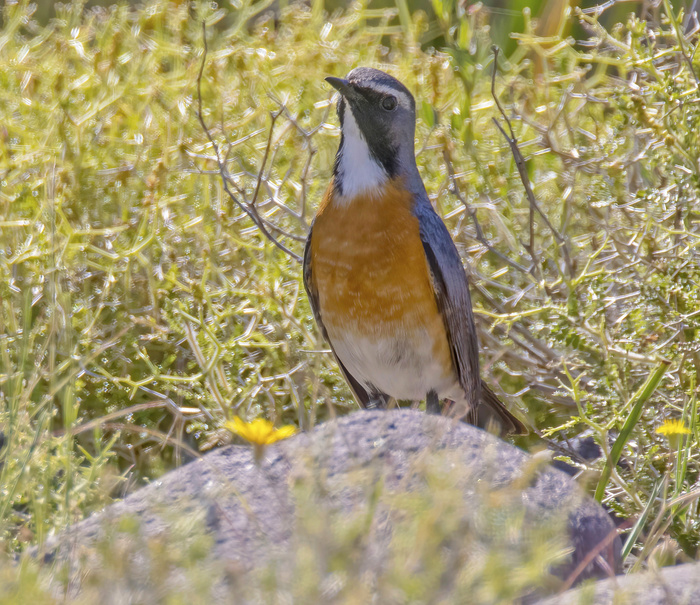
I was unashamedly shaking – I remember my whispered words now, there were only three “White Throated Robin”. Susan who had been walking five yards behind me ran up alongside and said “Oh please where is it”? – She knew full well the significance of what I had seen. Frustratingly it had dropped back down out of sight and I said “I can’t see it now” “Please don’t’ let me miss this bird” she pleaded. Suddenly there it was again out in full view in front of us. What a bird – what a find!!
I was carrying my Canon RF100-500 f7.1 lens attached to my Canon R5 and it’s fortunate that I was because there was no time to set anything up. If I had been lugging my Canon Ef600 f4 and tripod around there is no doubt I would have missed the shot. – Portability is everything in these situations. Then as the shutter fired I knew I had him – what a feeling to realise what I had achieved. This is a bird that we have fantasized about before all our trips to Lesvos, wondering what the feeling would be like to find and even better to photograph one – well now we knew! And it felt so good. We were genuinely elated, we watched it for about thirty seconds before it flew up and over a few bushes and it was gone – just unbelievable!
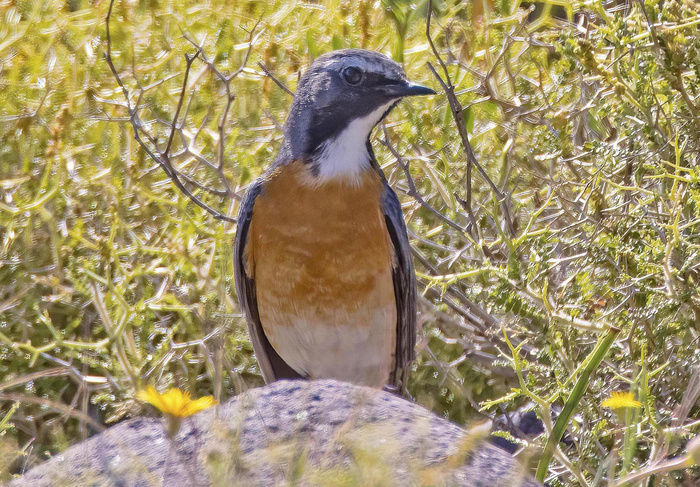
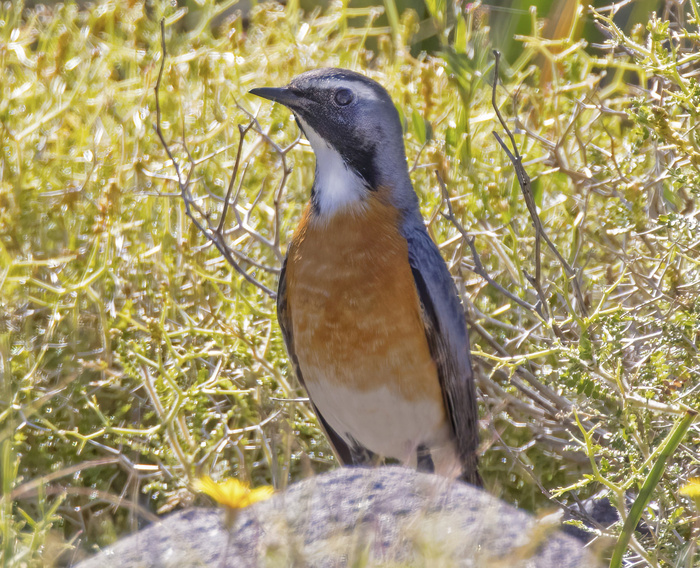
There is no mobile phone signal in that valley so we couldn’t tell anyone. Susan walked back down to the car to try and get a signal and when she arrived there was a Dutch birder there, a twitcher who I had been talking to a few days earlier. He came running up but he was too late, it had disappeared. I showed him the photos I had taken and he was amazed by our find. Many more people came later on but the bird disappointingly was never seen again.
Another birder we knew told us he had been talking to that same Dutch birder a few days after and he could tell by his conversation how missing a mega like that was really eating away at him, it’s just such bad luck.
However, that is not the end of this account. Another week had passed and we were again in the same area, not in any hope of seeing the Robin again, we knew that bird had flown, but to see other birds. As we stood there along the same track a Jeep approached and pulled up alongside us and a Greek man said “I am looking for the White Throated Robin”. I told him that was a week ago but he said he didn’t care and that he had to find it. I said that we were the people who had found it and he began shaking my hand warmly and congratulating me. His next request was unusual, he asked me to show him the bush where the bird was found. I found it a bit strange but he appeared genuine so I obliged as it was only fifty yards away. On arrival he stared at the bush like he was on some sort of pilgrimage to a holy site. I offered to show him an image and he said” You have images too” I showed him a close up and after looking at it he buried his face in his hands and just groaned.
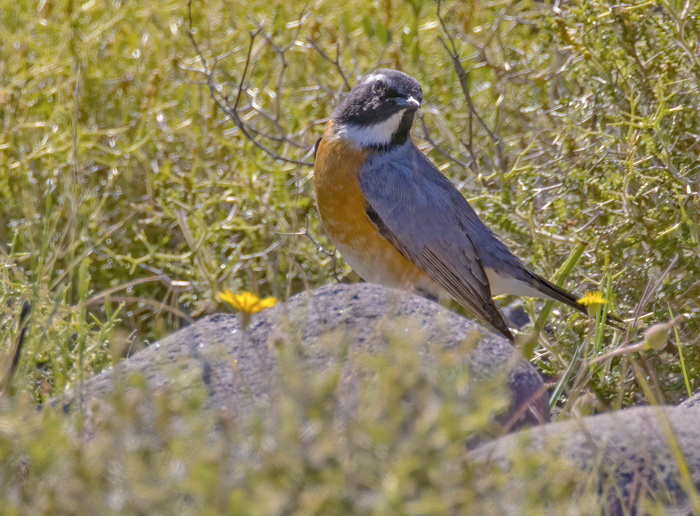
He told us it was his dream bird and he had been walking these isolated tracks for years trying to find one. I now realised I was looking into the face of a genuinely desperate man.
He walked a few yards further down the track and one of the two other younger men who were in the vehicle with him, after also seeing the images, told us he was the top bird lister in Greece and he had flown in from central Greece to try and find the bird. Out of the 403 birds on the Greek list he had seen 387 - that is serious twitching in your own country. As we left I wished him good luck and I told him I truly hoped he would find his dream bird one day.
After we left I felt strangely guilty – to offer an analogy I imagined how a metal detectorist of many years standing who had never had a really good find would feel when a complete novice who has a metal detector as a Xmas present goes out on his first trip and finds a bag of Saxon gold coins.
The fickle nature of our find also dawned on us because when thinking back to the day, if we hadn’t had to stop for that old sheep farmer we may well have gone past and seen nothing – C’est la vie!!
We now have to submit our find to the relevant Hellenic bird authorities.
There are certain dates etched into my memory and now April 24th 2023 is one of them. It was a warm and sunny Lesvos morning and Susan and I had been up and on the road before first light. We were travelling to the legendary Meladia valley, this valley is bisected by a very old and rough track which was in times gone by the only means of connecting the towns of Eresos and Sigri on the west of the island. Many epic bird sightings have been encountered in this valley and indeed last year Susan and I saw over a hundred Red Backed Shrikes and over five hundred Spotted Flycatchers on a morning there. Some people won’t travel the track for fear of getting stuck in the middle of nowhere and this is justifiable because over the years the track has been frequently closed because of rock falls and subsidence.
We navigated the roughest part of the track and had seen some nice birds, Little Owl, Rock Nuthatch, Red backed Shrike, etc. while Bee- eaters flew overhead – their fluty trills echoing around the valley. We stopped at the Meladia river ford – another iconic place for birders, where we encountered Common Sandpipers, Ruddy Shelduck, Lesser Whitethroat and Collared Flycatcher.
We locked the car and walked along an old rough track that runs between olive and fig groves - our targets were warblers. In particular, Orphean, Icterine, Olivaceous and hopefully Barred. After about two hundred yards an old farmer came along driving about a hundred sheep and he asked us to wait until he got the animals into a grazing meadow. We exchanged pleasantries and we were surprised by how much he knew about Wales. He thanked us for waiting and we said our goodbyes. On we walked while admiring the myriad of wild flowers that lined the track, we had seen a few birds, nothing special but that didn’t matter because it was a glorious morning and it was just nice to be out early. The habitat had now changed to low growing and quite aromatic bushes and shrubs interspersed with small rocks. Suddenly I saw something move at the bottom of a bush about ten yards away and I caught a flash of white and then some orange, my first thoughts were male Common Redstart which would have been nice, however, nothing could have prepared me for what was about to happen – a full summer plumaged adult male White Throated Robin perched on a small rock in front of me.

I was unashamedly shaking – I remember my whispered words now, there were only three “White Throated Robin”. Susan who had been walking five yards behind me ran up alongside and said “Oh please where is it”? – She knew full well the significance of what I had seen. Frustratingly it had dropped back down out of sight and I said “I can’t see it now” “Please don’t’ let me miss this bird” she pleaded. Suddenly there it was again out in full view in front of us. What a bird – what a find!!
I was carrying my Canon RF100-500 f7.1 lens attached to my Canon R5 and it’s fortunate that I was because there was no time to set anything up. If I had been lugging my Canon Ef600 f4 and tripod around there is no doubt I would have missed the shot. – Portability is everything in these situations. Then as the shutter fired I knew I had him – what a feeling to realise what I had achieved. This is a bird that we have fantasized about before all our trips to Lesvos, wondering what the feeling would be like to find and even better to photograph one – well now we knew! And it felt so good. We were genuinely elated, we watched it for about thirty seconds before it flew up and over a few bushes and it was gone – just unbelievable!


There is no mobile phone signal in that valley so we couldn’t tell anyone. Susan walked back down to the car to try and get a signal and when she arrived there was a Dutch birder there, a twitcher who I had been talking to a few days earlier. He came running up but he was too late, it had disappeared. I showed him the photos I had taken and he was amazed by our find. Many more people came later on but the bird disappointingly was never seen again.
Another birder we knew told us he had been talking to that same Dutch birder a few days after and he could tell by his conversation how missing a mega like that was really eating away at him, it’s just such bad luck.
However, that is not the end of this account. Another week had passed and we were again in the same area, not in any hope of seeing the Robin again, we knew that bird had flown, but to see other birds. As we stood there along the same track a Jeep approached and pulled up alongside us and a Greek man said “I am looking for the White Throated Robin”. I told him that was a week ago but he said he didn’t care and that he had to find it. I said that we were the people who had found it and he began shaking my hand warmly and congratulating me. His next request was unusual, he asked me to show him the bush where the bird was found. I found it a bit strange but he appeared genuine so I obliged as it was only fifty yards away. On arrival he stared at the bush like he was on some sort of pilgrimage to a holy site. I offered to show him an image and he said” You have images too” I showed him a close up and after looking at it he buried his face in his hands and just groaned.

He told us it was his dream bird and he had been walking these isolated tracks for years trying to find one. I now realised I was looking into the face of a genuinely desperate man.
He walked a few yards further down the track and one of the two other younger men who were in the vehicle with him, after also seeing the images, told us he was the top bird lister in Greece and he had flown in from central Greece to try and find the bird. Out of the 403 birds on the Greek list he had seen 387 - that is serious twitching in your own country. As we left I wished him good luck and I told him I truly hoped he would find his dream bird one day.
After we left I felt strangely guilty – to offer an analogy I imagined how a metal detectorist of many years standing who had never had a really good find would feel when a complete novice who has a metal detector as a Xmas present goes out on his first trip and finds a bag of Saxon gold coins.
The fickle nature of our find also dawned on us because when thinking back to the day, if we hadn’t had to stop for that old sheep farmer we may well have gone past and seen nothing – C’est la vie!!
We now have to submit our find to the relevant Hellenic bird authorities.
Spring.
13th April 2023
13th April 2023
It's finally arriving, wild flowers are bloominhg - Lesser Celandine, Wood Anenome, Primrose and soon the Bluebells. Chiffchaffs and Blackcaps are singing, Common Redstarts have appeared. I heard a lone and early Garden Warbler this week and Willow Warblers will be here in numbers soon, Cettis Warblers are chasing each other through the undergrowth and the first scratchy song of the Reed Warbler is being heard. Pied Flycatchers are in the woodlands investigating nesting areas. Hundreds of Swallows and Sand Martins are hunting insects over the local lakes and the iconic song of the Cuckoo will be heard from the hillsides in the coming days - best time of the year.
Two images taken on a walk yesterday.
Chiffchaff anongst Blackthorn blossom.
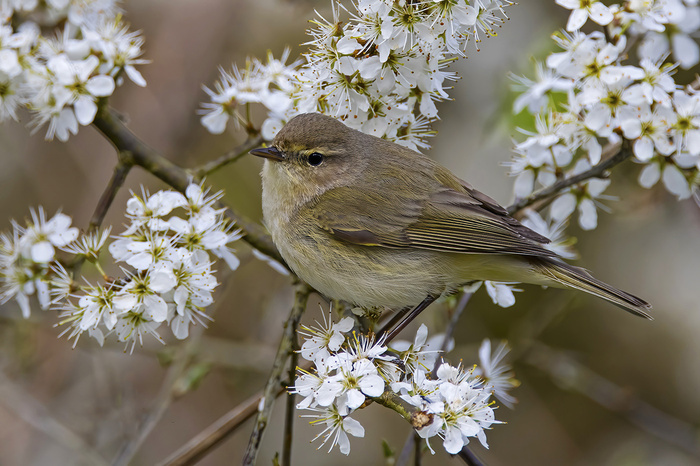
Little Grebe exibiting nice summer plumage.
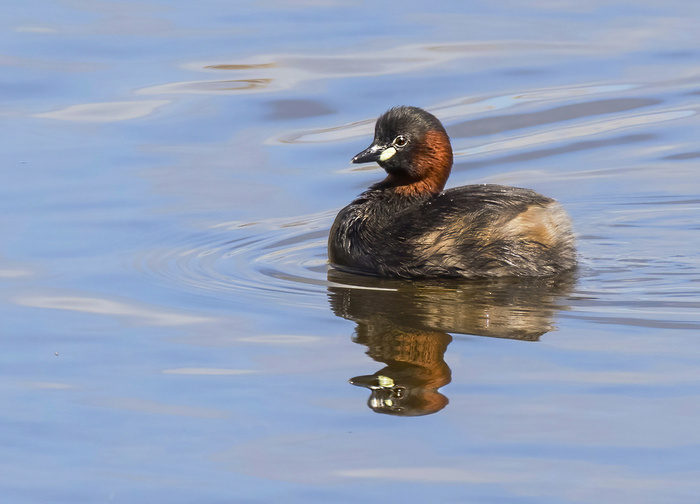
Two images taken on a walk yesterday.
Chiffchaff anongst Blackthorn blossom.

Little Grebe exibiting nice summer plumage.

More from my garden 'Hide'.
11th March 2023
11th March 2023
I’m continuing to endure the cold in my permanent hide that is in the little ‘wild’ area of my garden. In this current cold spell I have been spending the hours trying to photograph the visiting small birds attracted to the food I have put out. I have a small parabolic heater in the hide that I light to try and combat the cold, this is just basically a burner attached to a small gas canister and the heat is reflected by a metal radar-like dish. It really works well but it can only be used in ventilated areas for obvious reasons. The heat just takes the edge off the cold air which would be very uncomfortable otherwise. A flask of coffee helps and also a text message from Susan telling me the home made Pizzas she had made were ready for picking up - which was even more welcome!!
It may not seem cold while out walking for instance but sitting still for long periods of time does get very cold indeed and once you are that cold there’s no coming back it just gets worse.
The species of birds remains basically the same which is a bit disappointing but that’s the way it is and you have to take what you can get.
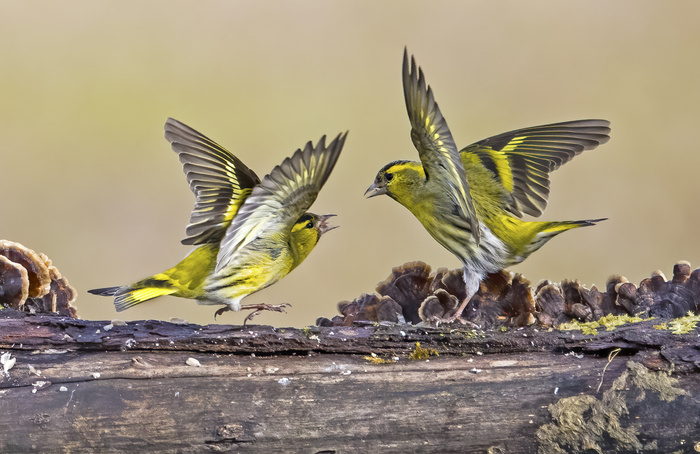
The Siskins are just as acrimonious as the Goldfinches.
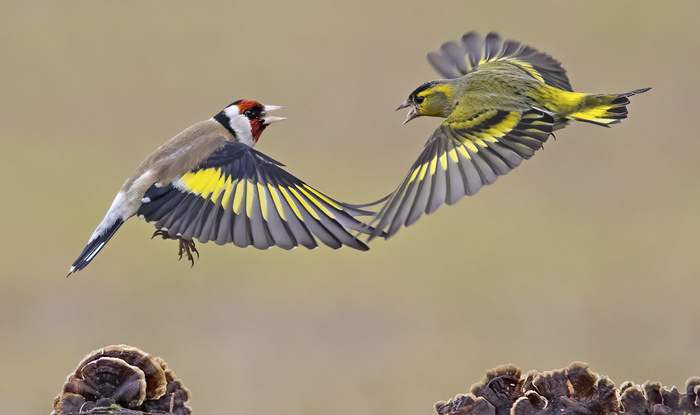
I have been hoping the male Sparrowhawk will visit but no luck so far, but I know he is around so it’s a matter of waiting.
The canon R5 and RF100-500 lens continue to perform admirably and I am very impressed by this combo – it bodes well for holidays this year.
I am waiting for the next bright day to try again.
It may not seem cold while out walking for instance but sitting still for long periods of time does get very cold indeed and once you are that cold there’s no coming back it just gets worse.
The species of birds remains basically the same which is a bit disappointing but that’s the way it is and you have to take what you can get.

The Siskins are just as acrimonious as the Goldfinches.

I have been hoping the male Sparrowhawk will visit but no luck so far, but I know he is around so it’s a matter of waiting.
The canon R5 and RF100-500 lens continue to perform admirably and I am very impressed by this combo – it bodes well for holidays this year.
I am waiting for the next bright day to try again.
Photographing small birds with a new perch.
04th March 2023
04th March 2023
I’m always on the lookout for interesting perches for my bird and indeed other wildlife photography. In view of this last week I was walking along a field edge and I came across some fallen tree branches and on closer inspection on the one side was a lovely collection of ‘Turkey tail’ fungi, so named obviously because of its resemblance to a Turkey’s tail feathers. I tried to lift one of the branches up to take back home with me, a distance of about half a mile, but it was far too heavy because as I found to my dismay, it was connected to a much bigger and heavier branch. Abandoning this for another day I proceeded to look for other likely perches but there were none, at least none as nice as the one I wanted most. I rarely give up so two days later I returned with a chainsaw and cut off a section of this fallen branch to take home, however, I had underestimated the weight of even this small branch, and combined with the weight of the chainsaw by the time I got home I really felt it - even small branches are always heavier than they look!!
The next day I removed the previous perch that I had used for the images of the Goldfinches in mid-air (in the last blog post), and using a battery drill I fixed two new posts to two permanent fence posts and then cut the tops off with a chainsaw and made sure they were even using a spirit level – it’s important to do this. I cut two similar grooves in the perch as with the last perch because it seemed to work well and I fixed the new perch across the top of these posts using very long fencing nails because it was five inches deep and when I will want to change it, it’s much easier than trying to remove very long screws.
I was all set now and the following sunny day I filled the grooves on the new perch with sunflower seeds. (I had kept the usual bird feeders topped up between photo-shoots to keep the birds interested). Once again I removed all these other feeders because it doesn’t take long for birds to locate a new source of food, especially this time of year.
I set up my equipment again as described in the previous blog and below is a small selection of the results.
It's so important to set your perches up to suit the light, everybody knows how sunlight behaves in their own garden so a little bit of effort goes a long way to achieving good results and bright light from the right direction is fundamental for giving these images the 'Pop' an overcast day just can't produce.
Goldfinches fighting.
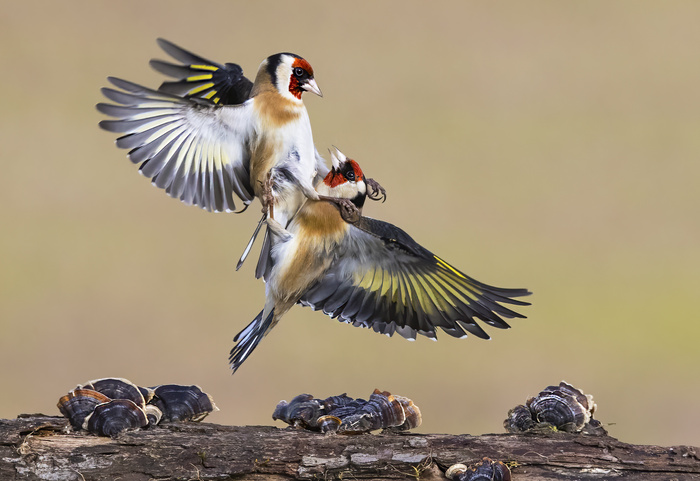
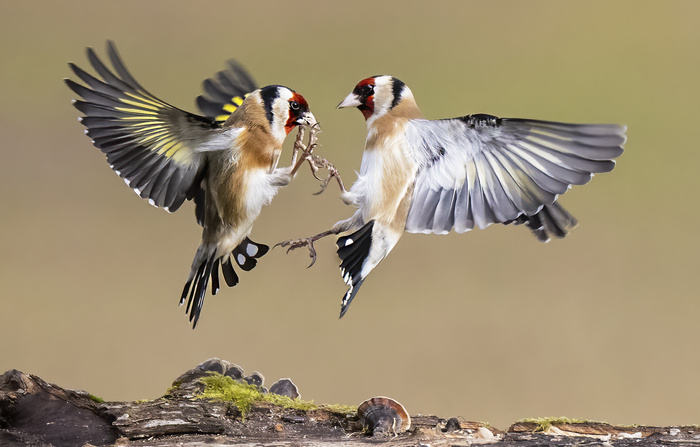
Chaffinch
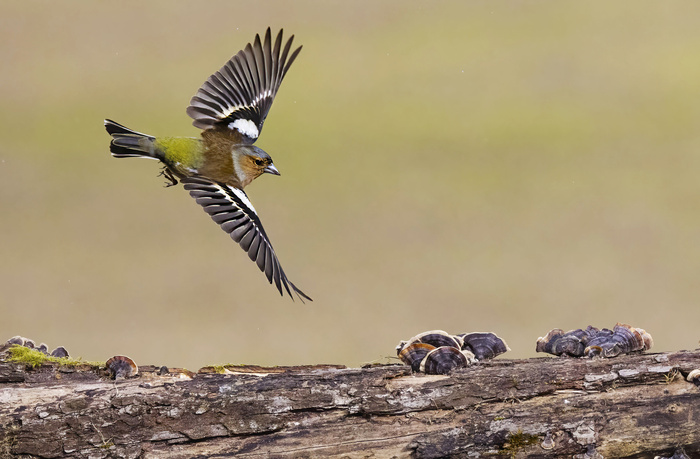
Siskin @ 5000/sec
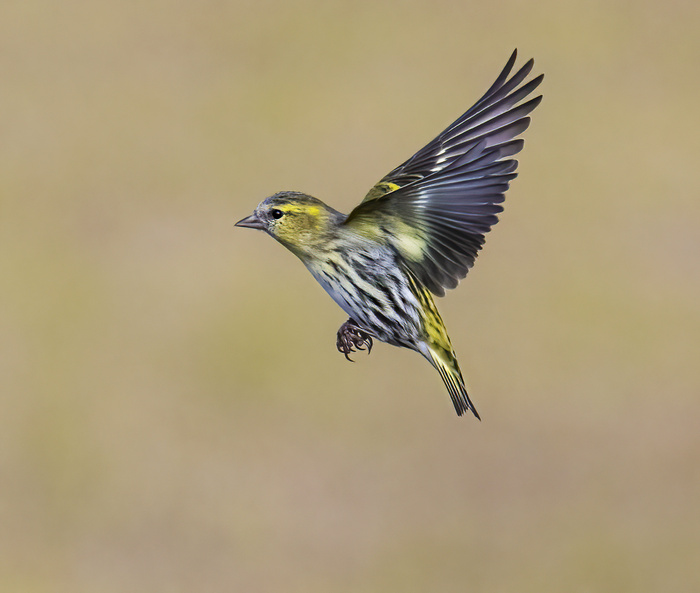
The next day I removed the previous perch that I had used for the images of the Goldfinches in mid-air (in the last blog post), and using a battery drill I fixed two new posts to two permanent fence posts and then cut the tops off with a chainsaw and made sure they were even using a spirit level – it’s important to do this. I cut two similar grooves in the perch as with the last perch because it seemed to work well and I fixed the new perch across the top of these posts using very long fencing nails because it was five inches deep and when I will want to change it, it’s much easier than trying to remove very long screws.
I was all set now and the following sunny day I filled the grooves on the new perch with sunflower seeds. (I had kept the usual bird feeders topped up between photo-shoots to keep the birds interested). Once again I removed all these other feeders because it doesn’t take long for birds to locate a new source of food, especially this time of year.
I set up my equipment again as described in the previous blog and below is a small selection of the results.
It's so important to set your perches up to suit the light, everybody knows how sunlight behaves in their own garden so a little bit of effort goes a long way to achieving good results and bright light from the right direction is fundamental for giving these images the 'Pop' an overcast day just can't produce.
Goldfinches fighting.


Chaffinch

Siskin @ 5000/sec
